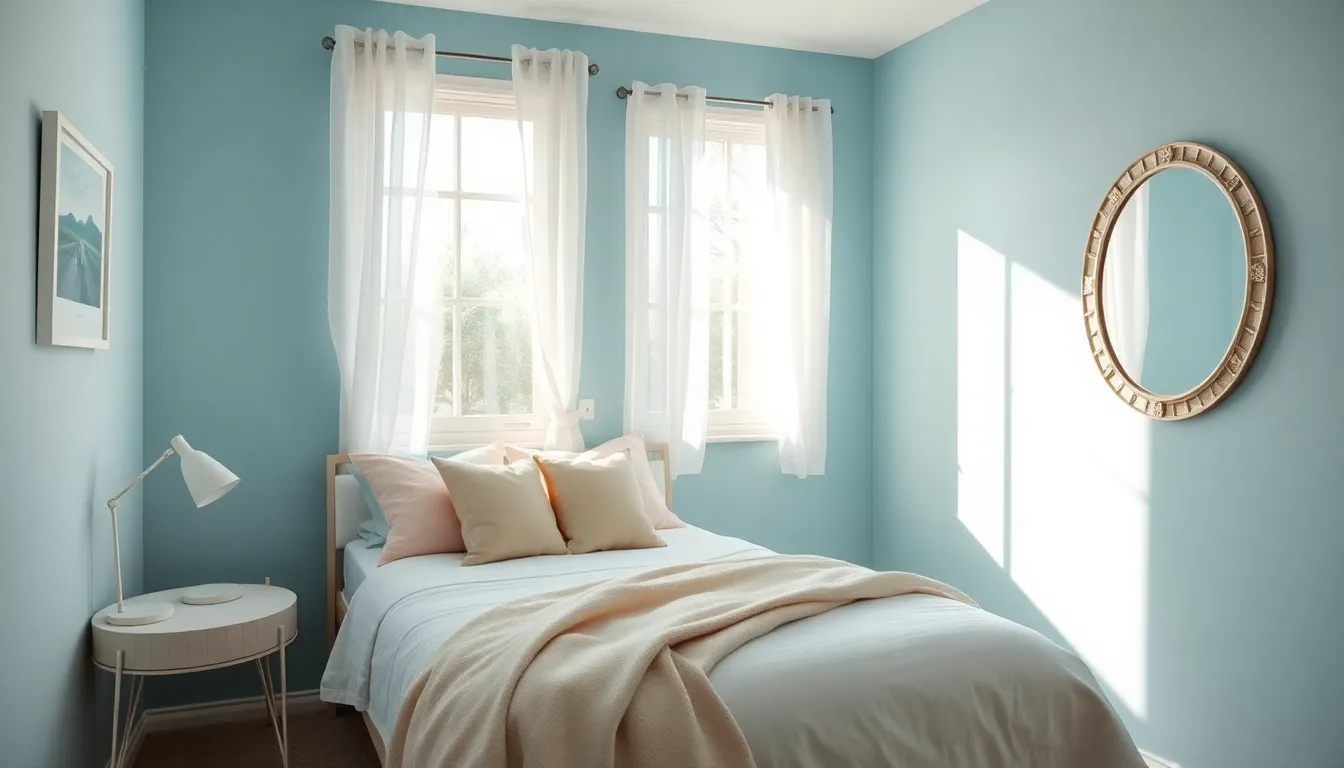Choosing the right paint color for a small bedroom can feel like trying to find a needle in a haystack—if the haystack were also painted in fifty shades of beige. Fear not, though! The right hue can transform a cramped space into a cozy retreat that feels larger than life. Whether it’s a serene blue that whispers sweet dreams or a bold yellow that energizes the soul, the perfect color can make all the difference.
Table of Contents
ToggleOverview of Paint Colors for Small Bedrooms
Selecting the right paint color transforms a small bedroom into a welcoming retreat. Soft colors such as pale blue or light gray create an illusion of space, making the room feel larger. Warm hues like soft peach or creamy white add coziness without overwhelming the senses.
Choosing bold colors can also work effectively in small spaces. Rich shades like deep green or navy blue can create a dramatic effect, especially when paired with good lighting. Neutral colors serve to anchor the room while adapting to various decor styles, ensuring longevity.
Considering the finish of the paint plays a crucial role in light reflection. Matte finishes absorb more light, which may not enhance small spaces. On the other hand, satin or eggshell finishes reflect light, adding brightness to the bedroom environment.
The placement of colors affects visual perception. Painting the ceiling a lighter shade than the walls can make the room feel taller. Incorporating an accent wall with a deeper hue adds depth without dominating the space.
Natural light’s availability impacts color choices. Rooms with ample sunlight can handle darker shades since the light balances the depth. Dimly lit spaces benefit from light colors to generate warmth and openness.
Every choice in paint color contributes to establishing a mood in the bedroom. Calming colors enable relaxation while energizing shades inspire creativity. Prioritizing personal preference and comfort alongside these principles creates a harmonious living space.
Best Paint Colors for Small Bedrooms

Selecting the right paint colors significantly alters the perception of space in small bedrooms. Both light and dark hues can transform a small room into a more inviting atmosphere.
Light Colors to Make a Room Feel Bigger
Light colors create an illusion of space. Soft pastels like pale blue and blush pink expand the boundaries, crafting an airy feel. Light gray also contributes to a sleek, modern aesthetic, enhancing natural light. White reflects brightness, making corners seem less confined. When using these tones, consider the ceiling color; lighter ceilings elevate the perception of height. For maximum effect, incorporate satin or eggshell finishes that bounce light, further enlarging the visual scope.
Dark Colors for Cozy Ambiance
Dark colors can establish a cozy retreat within a small bedroom. Rich tones like deep green or navy create an intimate environment. These shades evoke comfort while offering a sophisticated touch. To prevent the room from feeling too enclosed, balance dark walls with ample lighting. Installing dimmable lamps or using mirrors enhances the room’s brightness. Accent walls in darker shades can provide depth without overwhelming the space when paired with lighter textiles and decor.
Tips for Choosing the Right Shade
Selecting the perfect paint color for a small bedroom involves careful consideration of various factors.
Consider Natural Light
Natural light significantly influences how colors appear in a room. Lighter shades reflect sunlight, making spaces feel larger and airier. Rooms with abundant natural light can accommodate darker hues, which create warmth. Dimly lit spaces benefit from soft pastels or whites, enhancing brightness. Testing paint samples on the walls at different times of day reveals how light alters color perception. Keep in mind that north-facing rooms often require warmer tones to counterbalance cooler light.
Think About Room Functionality
Room functionality shapes color choice significantly. Bedrooms designed for relaxation benefit from soothing hues like soft blues and calm grays, which promote tranquility. Bright, energetic colors, such as yellows or vibrant greens, suit active spaces for children or creative pursuits. Furniture and decor compatibility also matters; cohesive color palettes unify the overall aesthetic. Imagining how the room will be used can guide color selection effectively, ensuring the space meets both practical needs and visual appeal.
Popular Color Palettes
Exploring color palettes can simplify the decision-making process for small bedrooms. Many options exist, each offering unique visual effects.
Monochromatic Schemes
Monochromatic schemes utilize varying shades of a single color. This technique creates a harmonious look while maintaining depth. For example, different tones of soft blue can evoke tranquility, making the space feel expansive. Additionally, textures such as bedding and curtains enhance the effect, adding dimension without overwhelming the senses. Soft grays work similarly, promoting calmness while allowing for subtle contrasts with furnishings. Choosing this approach enables a cohesive aesthetic without sacrificing warmth.
Complementary Color Combinations
Complementary color combinations involve pairing colors from opposite ends of the color wheel. These combinations bring balance and vibrancy to small bedrooms. For instance, a rich navy blue can contrast beautifully with a bright peach, creating an inviting atmosphere. Accents such as throw pillows or artwork can incorporate these hues, introducing visual interest. Warm neutrals serve to anchor the vibrant colors, making the space feel grounded and cozy. Incorporating complementary palettes enhances energy levels while maintaining sophistication in design.
Choosing the right paint color for a small bedroom can truly transform the space. By understanding how colors interact with light and space, it’s possible to create an inviting atmosphere that feels larger and more comfortable. Whether opting for soft pastels to enhance openness or bold hues for a cozy retreat, the impact of color is undeniable.
Consideration of natural light and the room’s functionality plays a crucial role in making the best choice. With the right color palette and finish, small bedrooms can become personal sanctuaries that reflect individual style and promote relaxation. Ultimately, the perfect paint color not only enhances aesthetics but also elevates the overall mood of the space.


